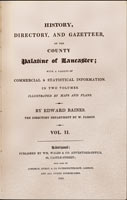
HISTORY, DIRECTORY, & GAZETTEER, of the COUNTY PALATINE of LANCASTER in TWO VOLUMES |
||||
page 443 |
valley, and is fast assuming the form of a regular town. There is here a small episcopal chapel, subject to Oldham, called St. Paul's, built in the year 1754, on land presented by Thomas Percival, Esq. of Royton Hall, for that purpose. The mansion called Royton Hall was long in the possession of the Byron family, (the ancestors of the illustrious poet of that name) and who were the principal proprietors of the soil. After the decease of Mr. Percival, this hall was occupied by Joseph Pickford, Esq, (afterwards Sir Joseph Radcliffe, Bart.) but it is now falling into decay. This township has the usual characteristics of the parish: the cotton manufactures prevail to a considerable extent, and valuable beds of coal are found under at least one-half the land. CHADDERTON is situated to the west of Oldham, and forms a right. angle with Royton. The early history of the township is chiefly distinguished for its two ancient mansions, Fox-denton-hall and Chadderton-hall, and for the families by whom they were occupied. At the period when the liberties of England began to assume a settled character, both these mansions were possessed by the Traffords, but soon after Magna Charta was granted by King John to the demands of his barons, Richard de Trafford conferred the lordship and manor of Chadderton upon his second son, Geoffrey. This Geoffrey assumed the name of Chadderton, and his daughter, Margaret, having married John Radcliffe, grandson of Richard de Radcliffe, of Radcliffe-tower, Fox-denton passed as a dowry into that family. The hall is now sharing the fate of Royton-hall. Chadderton-hall was the birth-place of Dr. Lawrence Chadderton, who lived at the period of the reformation, and was amongst the number of the principal reformers. Fuller says of this divine, that "he was intended for a lawyer, and in order thereto brought up some time in the inns of court, till he (was 20 years of age, when he) changed his profession, and admitted himself in Christ's College, at Cambridge. His father (who was nuzled up in popish superstition) hearing that he had altered his place, studies, and religion, sent him a poke with a groat therein, for him to go a begging therewith, disinheriting him of the fair estate of Chadderton, which otherwise had descended upon him." This eminent divine became master of Emanuel College, and survived, with sound faculties, to the patriarchal age of ninety-four years. Dr. William Chadderton, bishop of Chester, and one of the ecclesiastical commissioners for Lancashire, along with Henry Earl of Derby, in the reign of Elizabeth, appears to have been a member of this family. The father of Dr. Lawrence Chadderton having disinherited his son, and bequeathed his estates to the Radcliifes, Chadderton passed by marriage to Edmund Assheton, son of Sir John Assheton, of Ashton-under-Line, who married Joan the daughter and coheiress of Richard Radcliffe. About the year 1690, William Assheton, a descendant of Edmund, sold the manor and estate of Chadderton to Joshua Horton, Esq. of Howroyd, in the county of York, which possession, on the death of his father in 1708, descended to Thomas Horton, whose son William was created a baronet in 1764, and was succeeded by his son Sir Watts Horton, Bart. in 1774, who, by marriage with Henrietta, daughter of James Lord Strange, became allied to the Stanley family. During the time of Sir Watts Horton, Chadderton was in its zenith: the house was well stored with pictures, and the park and pleasure grounds, with their bold and varied scenery, appeared to the greatest advantage. Sir Watts, dying without male issue in 1811, was
|
|||
